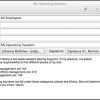|
|
Journey to Agility: Leading the Transformation How far can you take agile within an organization? Is it enough to just focus on agile development practices such as Scrum and XP or is something more needed? Agile is much more than just a development methodology. Beyond product development, it can become an organizational strategy for increased success. Skip Angel shares an example of one company's journey from no knowledge of agile to an organization of high agility. He answers many of your questions about transformation that can help your company on its journey to agility, especially how to get started. Skip describes the preconditions a company must be ready to accept-significant organizational changes and the major activities and events that happen during the transformation process. Agile changes organizations in terms of who they are, how they think, and what they can achieve.
|
Skip Angel, BigVisible Solutions
|
|
|
Implementing Agile in an FDA-regulated Environment While many industries have adopted agile, the medical device industry, which develops products for life-critical applications-where quality and reliability are clearly a top-priority, remains largely stuck under the “waterfall.” Medical device firms must comply with FDA regulations that overwhelmingly suggest a controlled, phase-gated approach to software development. Unfortunately, many companies and development organizations interpret FDA regulations to require a steep waterfall. Many industry long-timers incorrectly see agile as an undisciplined style of software development. Neeraj Mainkar demonstrates how those in regulated industries can overcome these and other hurdles. At Neuronetics, he helped implement key elements of agile while fully complying with FDA regulations.
|
Neeraj Mainkar, Neuronetics
|
|
|
Performance Appraisals for Agile Teams Traditional performance evaluations, which focus solely on individual performance, create a “chasm of disconnect” for agile team members. Because agile is all about team performance and trust, the typical HR performance evaluation system is not congruent with agile development. Based on his practical experience leading agile teams, Michael Hall explores how measurements drive behavior, why team measurement is important, what to measure, and what not to measure. Michael introduces tangible techniques for measuring agile team performance-end of sprint retrospectives, sprint and project report cards, peer reviews, and annual team performance reviews. To demonstrate what he’s describing, Michael uses role plays to contrast traditional, dysfunctional annual reviews with agile-focused performance reviews.
|
Michael Hall, WorldLink, Inc.
|
|
|
Enterprise Agile: From the Top Down Now that agile has gone mainstream, team-level development is not the only way organizations are implementing agile. Some senior management teams are trying to understand how they can implement agile-and lean-principles and practices from the top down. Jon Stahl demonstrates agile and lean techniques applied in a new way with certain constraints. With these techniques, your organization can begin its journey toward becoming an agile enterprise. However, before beginning, it is important that management “see the whole”-customers, projects, applications, people, leadership, financials, and standard work products-and start implementing and practicing the culture they wish to create. To help PMOs support this journey, Jon shares some guiding principles that can be applied to both agile and waterfall approaches.
|
Jon Stahl, LeanDog Software, Inc.
|
|
|
Why Continuous Improvement Programs Fail: Can Kaizen and WIP Help? If you have established an agile or lean development approach and aren’t experiencing meaningful innovations or improvements in your process, this session is for you. Michael DePaoli shares an interdisciplinary understanding of why change initiatives so often fail and what to do about it. Join Michael and your peers to explore the neuroscience behind change and review the patterns of cultural, organizational, and behavioral dysfunction that impede improvement efforts. To address these challenges, Michael explores the kaizen philosophy of change and why optimizing from a current situation is often better than attempting revolutionary changes. Through the use of an innovation game, you’ll have an opportunity to share your challenges with continuous improvement and work with Michael and other participants to map out a new approach.
|
Michael DePaoli, VersionOne, Inc.
|
|
|
Management Myth #9: We Have No Time for Training It’s never easy to schedule training, but you must if you want the people you manage to learn a new language, tool, or skill. Johanna offers some tips for making time and capitalizing on curiosity.
|
|
|
|
Surprise! Making the Most Out of Your Most Surprising Moments Lee Copeland explains that surprise is often an indicator that discovery, learning, or even delight may be just around the corner. The surprise itself can be amusing, enlightening, befuddling, disconcerting, or frightening, but surprise should not be the end of the experience; it should be the beginning. Analyze the surprise to learn why you didn't see it coming and what you gain from that.
|
|
 |
Achieve CM Excellence through People, Not Tools Great tools and process are not the best formula for software configuration management excellence. Leslie Sachs writes that the most important resources for configuration management excellence are people—the technology professionals and the leaders who guide the team toward CM excellence. This article will help you understand what psychologists have learned regarding some of the essential qualities found among top leaders and others who consistently achieve excellence.
|
|
 |
Management Myth #8: I Can Still Do Significant Technical Work The temptation can be incredibly strong for managers—especially new ones—to step in when a technical problem arises. But, that isn’t a very good show of faith in one’s team members. Johanna Rothman writes that as a manager, you have to delegate a problem and leave it delegated.
|
|
 |
Management Myth #7: I Am too Valuable to Take a Vacation There's a common myth among managers—that they are the only drivers and decision makers for their teams and, therefore, can't take time off. In reality, regardless of the team or workgroup you manage, your team makes decisions without you all the time.
|
|

